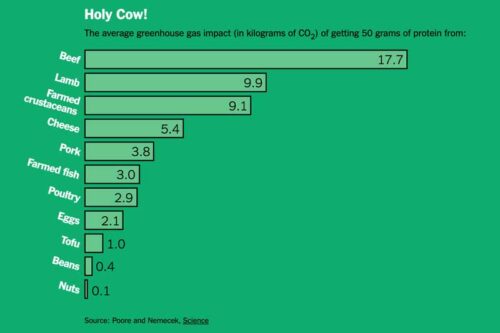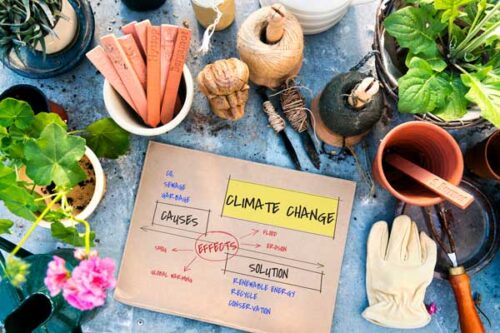Climate Change
Everone needs to do their part to help mitigate climate changeToday’s food system creates over 25% of total greenhouse gas emissions, a huge contributor to climate change. The majority of these emissions come from animal agriculture, from cutting down forests to create grazing land or feedlots, to chemical fertilizers and pesticides used on crops to feed the animals, to the amount of methane produced from the digestion process of livestock (i.e., belching and farts).

And if today’s impact of meat on climate change is troubling, the Food and Agriculture Division of the United Nations predicts that world meat production will double by 2050 if nothing is done to change eating habits in most places around the world, and especially in high meat-eating countries such as the U.S. and Australia.
If you live in a country like the United States, the best way to help decrease the impact of animal agriculture on climate change is to eat less meat and add more fruits and vegetables to your diet. Over 100 scientists from 52 countries published the United Nations’ Intergovernmental Panel on Climate Change report and found that if the world’s population shifted toward a plant-based diet (meaning reducing meat and focusing on eating whole foods, not processed), it could greatly help in combating climate change.
Though it can vary, some studies have shown that heavy meat eaters like in the U.S. and Europe who shift to a vegetarian diet can shrink their food footprint by one third or more. Going vegan would reduce those emissions even further. If you aren’t interested in a plant-based diet, a World Resources Institute analysis reported that replacing one third of the beef an average American eats with pork, poultry or legumes, his or her food-related emissions would still fall by almost 13 percent.
Climate-Friendly Gardens
Another way to help combat climate change is to plant a regenerative garden. Not every type of garden is climate friendly, so you need to focus on eco-friendly practices, such as:
- Avoid using peat-based compost – Peat bogs in nature are wonderful for the environment. Purchasing peat compost depletes resources
- Do not use manure (it releases methane into the air)
- Do not till or break up the soil
- Eliminate chemical pesticides
- Eliminate chemical or synthetic fertilizers
- If you have one, only use energy efficient greenhouses
- Include plants that attract pollinators and beneficial insects
- Use compost to build soil health (create your own!)
- Use a rain barrel to capture water for the plants
To be a climate- or eco-friendly gardener, you can try out or adapt principles from:
- Agroforestry – Agriculture with trees, and so much more!
- Forest gardening – Planting gardens that mimic a forest
- Orchards – Plant trees that provide food!
- Organic gardening – Shun the chemical pesticides and fertilizers
- Permaculture – Let nature do the work
- Rain garden – Create a garden of food and flowers that also captures rainwater
- Regenerative growing – Put nutrients back in the soil and back in your body!
- Vegan organic gardening – organic gardening with no manure, blood or other animal input
- Water-wise gardening – Gardening in a way that reduces water consumption as much as possible
- Wildlife garden – Grow plants that attract birds, bees, beneficial insects and small mammals
How To
There are many ways to create a climate- and eco-friendly garden. Real Homes has some great suggestions.
Plant Eat Share
How can planting food in a regenerative manner in your community and sharing it with others (for free!) help mitigate climate change? Some ways include:
- Having a free source of fruits and vegetables will encourage individuals to eat less meat and possibly go vegetarian. Beef – and meat – are large contributors to climate change. If you are going to eat meat, find local, pasture-raised sources. It will also encourage individuals to try local produce they might not be so familiar with.
- The more local, the less a food will travel, cutting down on transportation pollution. The U.S. transportation sector creates approximately one third of the country’s climate change emissions, and the average U.S. meal travels 1,500 exhaust-producing miles to your plate.
- More regenerative gardens means less chemical fertilizers and pesticides put on grass, which is also the largest U.S. irrigated crop.
- Food forests contain shrubs and trees, which help absorb carbon and release oxygen. Even the plants in your garden help absorb carbon while healthy roots keep the carbon in the ground. Carbon emissions contribute to climate change.



